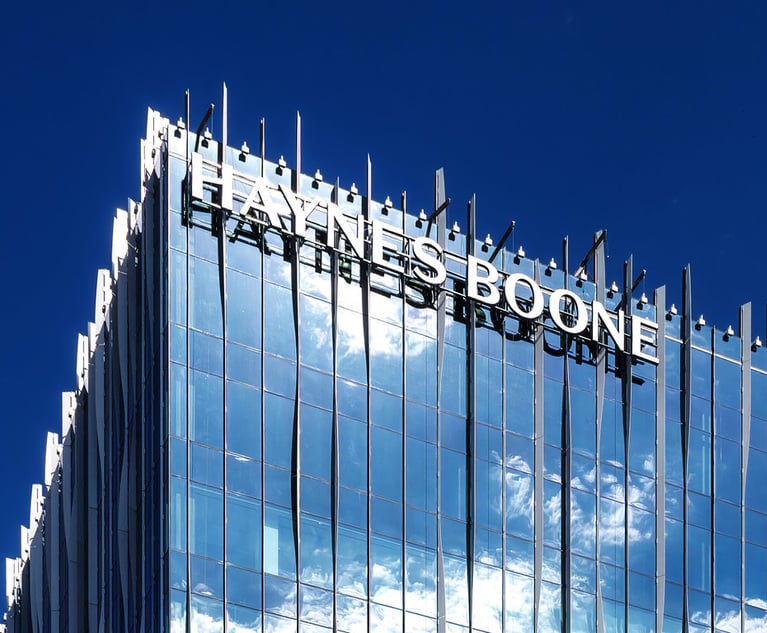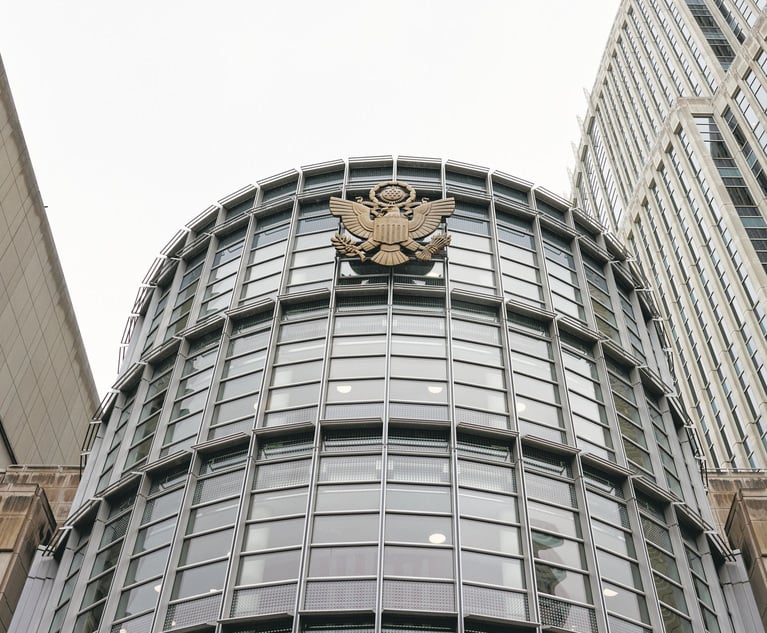NY Tax Lawyers: IRS Has Made It Difficult for High-Earning Lawyers to Game System
Licensing spinoffs? Partnerships of associates? The IRS and Treasury Department anticipated how law firms might try to take advantage of Trump's tax reforms—and said no way.
August 10, 2018 at 12:51 PM
6 minute read
The original version of this story was published on Daily Report
 (Photo: Shutterstock.com)
(Photo: Shutterstock.com)
To the chagrin of creative tax lawyers who saw promising loopholes in the Trump administration's sweeping tax reform legislation, the Internal Revenue Service has shut down avenues for high-earning lawyers to take advantage of a hefty new 20 percent deduction on pass-through partnership income.
In proposed regulations released Aug. 8, the IRS and Treasury Department addressed questions that have been raised about the new deduction for income from pass-through entities—and pointedly blocked the two main gambits for lawyers with law-firm-specific examples.
“They did a pretty good job,” said Alex Raskolnikov, a tax law professor at Columbia University. “They went so far as to specifically address in examples two work-around strategies, one for partners and one for associates.”
For most types of professional services firms—including law firms—Congress capped the new 20 percent deduction on pass-through business income at $157,500 for single filers and $315,000 for married joint filers in its December tax overhaul legislation.
But some pass-through entities, such as real estate partnerships, are eligible for the tax break with no income cap.
“This is such blatant favoritism,” Raskolnikov said. “Why is it that lawyers and doctors do not get this deduction, but architects, engineers and real estate owners do?”
“The closer you get to the real estate industry, the better things are for you in this bill,” he added.
Undeterred, earlier this year Raskolnikov and other tax whizzes rose to the challenge of finding a way for law partners to take advantage of the new deduction.
“We were not so optimistic when the tax reform act originally passed, because the statute expressly carved out lawyers that made more than $315,000 filing jointly from receiving this rate,” said David Miller, a tax partner at Proskauer Rose in New York.
Even so, they came up with some creative potential work-arounds.
One idea was to divide the law firm partnership into three separate partnerships. The main operating partnership would continue providing legal services and distributing profits to the partners. One spin-off would employ the staff and provide administrative services for a fee, while another would own the office building (if the firm had one) and rent it to the main partnership.
Raskolnikov's twist on this idea was to create another spin-off partnership to own the name of the law firm and license it back to the operating partnership for big bucks—the way Apple, Starbucks and Amazon do internationally to avoid posting profits.
 Alex Raskolnikov
Alex Raskolnikov“I would have thought my strategy was more promising, because not many big firms own their building,” he added.
If a firm like Cravath, Swaine & Moore, which distributed more than $332 million in profit to 83 equity partners last year, instead paid $332 million in licensing fees to a separate pass-through entity eligible for the tax break, that could mean major tax savings for each partner, as Raskolnikov has pointed out.
The spin-off partnerships theoretically could qualify for the 20 percent income deduction since their revenues would not be from providing legal services.
“That was the theory,” Miller said. “But the regulations expressly address this very scenario.”
An example on page 169 of the newly released, 184-page IRS regulations addresses a firm that creates two additional partnerships that it pays, respectively, for office leasing and administrative services.
If there is 50 percent or more common ownership of each of the three partnerships, the IRS said, they will be treated as a single entity, which it calls a “specified service trade or business” (SSTB), that is not eligible for the tax break.
“So forget it. No pass-through deduction,” Miller said.
The other lawyer-specific gambit would benefit associates. As employees, they are not eligible for the 20 percent deduction for pass-through income. The idea was to spin off a separate partnership of associates that would then contract their services to the main law firm partnership.
That could mean a big income tax savings for associates. Miller has calculated that an associate earning at the $315,000 joint-filer threshold could save about $15,000 annually.
But again, the new IRS regulations address this very situation. Since the associates are performing the same services as when they were employees, they are presumed for tax purposes to be employees, the IRS spells out on page 172 of the guidelines.
“If the associates are really under the control of the partnership, working in the same offices and providing the same services, effectively the regulations say: Think again,” Miller said.
Miller has not entirely given up on the notion of a partnership of associates. “If a few associates decide to form their own firm and can take some additional clients while still working for the law firm, it could be ok,” he said.
“But these were the last remaining avenues, and I think they've been entirely shut down in the regulations,” he conceded.
 David Shaviro
David ShaviroWhile high-earning partners in New York firms will not benefit from the 20 percent income deduction, lower-earning lawyers still can, Raskolnikov said. “A three-to-five-lawyer firm in Topeka may be below the income threshhold.”
The IRS, for now at least, has blocked ways that law firms could reorganize to take advantage of the 20 percent tax break, but some enterprising tax minds have not given up entirely. New York University tax professor Daniel Shaviro, for one, thinks there is still room for creative tax thinking regarding the sweeping tax overhaul legislation—which he deemed “a huge and arbitrarily designed giveaway.”
“So far as aggressive tax planning is considered, I think that in general [the IRS] will have more success in blocking the reorganization of pre-existing businesses and employment relationships to garner extra tax benefits, than the upfront design of creative new ones in light of the (perhaps in some cases unintended) planning opportunities that the provision offers,” he said in an email.
The bottom line? Gaming the new tax regime may be tough for professional services firms. But with legislation as extensive and complicated as this, never underestimate a tax lawyer's gifts.
READ MORE:
Taxing Questions for Law Firms Looking to Benefit in the New Regime
This content has been archived. It is available through our partners, LexisNexis® and Bloomberg Law.
To view this content, please continue to their sites.
Not a Lexis Subscriber?
Subscribe Now
Not a Bloomberg Law Subscriber?
Subscribe Now
NOT FOR REPRINT
© 2025 ALM Global, LLC, All Rights Reserved. Request academic re-use from www.copyright.com. All other uses, submit a request to [email protected]. For more information visit Asset & Logo Licensing.
You Might Like
View All
Haynes and Boone Expands in New York With 7-Lawyer Seward & Kissel Fund Finance, Securitization Team
3 minute read
Ticket-Fixing Scheme Results in Western NY Judge's Resignation—for a Second Time

Disbarred NY Atty Receives 54-Month Prison Sentence After $3M Embezzlement
3 minute read
Legal Community Mourns the Loss of Trailblazing Judge Dorothy Chin Brandt
Trending Stories
Who Got The Work
J. Brugh Lower of Gibbons has entered an appearance for industrial equipment supplier Devco Corporation in a pending trademark infringement lawsuit. The suit, accusing the defendant of selling knock-off Graco products, was filed Dec. 18 in New Jersey District Court by Rivkin Radler on behalf of Graco Inc. and Graco Minnesota. The case, assigned to U.S. District Judge Zahid N. Quraishi, is 3:24-cv-11294, Graco Inc. et al v. Devco Corporation.
Who Got The Work
Rebecca Maller-Stein and Kent A. Yalowitz of Arnold & Porter Kaye Scholer have entered their appearances for Hanaco Venture Capital and its executives, Lior Prosor and David Frankel, in a pending securities lawsuit. The action, filed on Dec. 24 in New York Southern District Court by Zell, Aron & Co. on behalf of Goldeneye Advisors, accuses the defendants of negligently and fraudulently managing the plaintiff's $1 million investment. The case, assigned to U.S. District Judge Vernon S. Broderick, is 1:24-cv-09918, Goldeneye Advisors, LLC v. Hanaco Venture Capital, Ltd. et al.
Who Got The Work
Attorneys from A&O Shearman has stepped in as defense counsel for Toronto-Dominion Bank and other defendants in a pending securities class action. The suit, filed Dec. 11 in New York Southern District Court by Bleichmar Fonti & Auld, accuses the defendants of concealing the bank's 'pervasive' deficiencies in regards to its compliance with the Bank Secrecy Act and the quality of its anti-money laundering controls. The case, assigned to U.S. District Judge Arun Subramanian, is 1:24-cv-09445, Gonzalez v. The Toronto-Dominion Bank et al.
Who Got The Work
Crown Castle International, a Pennsylvania company providing shared communications infrastructure, has turned to Luke D. Wolf of Gordon Rees Scully Mansukhani to fend off a pending breach-of-contract lawsuit. The court action, filed Nov. 25 in Michigan Eastern District Court by Hooper Hathaway PC on behalf of The Town Residences LLC, accuses Crown Castle of failing to transfer approximately $30,000 in utility payments from T-Mobile in breach of a roof-top lease and assignment agreement. The case, assigned to U.S. District Judge Susan K. Declercq, is 2:24-cv-13131, The Town Residences LLC v. T-Mobile US, Inc. et al.
Who Got The Work
Wilfred P. Coronato and Daniel M. Schwartz of McCarter & English have stepped in as defense counsel to Electrolux Home Products Inc. in a pending product liability lawsuit. The court action, filed Nov. 26 in New York Eastern District Court by Poulos Lopiccolo PC and Nagel Rice LLP on behalf of David Stern, alleges that the defendant's refrigerators’ drawers and shelving repeatedly break and fall apart within months after purchase. The case, assigned to U.S. District Judge Joan M. Azrack, is 2:24-cv-08204, Stern v. Electrolux Home Products, Inc.
Featured Firms
Law Offices of Gary Martin Hays & Associates, P.C.
(470) 294-1674
Law Offices of Mark E. Salomone
(857) 444-6468
Smith & Hassler
(713) 739-1250






